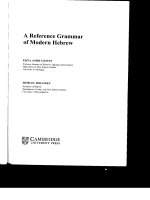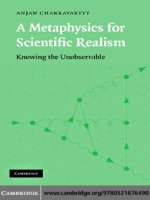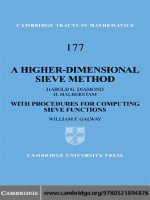052177151X cambridge university press a reference grammar of modern standard arabic sep 2005
Bạn đang xem bản rút gọn của tài liệu. Xem và tải ngay bản đầy đủ của tài liệu tại đây (6 MB, 736 trang )
This page intentionally left blank
A Reference Grammar of Modern Standard Arabic
A Reference Grammar of Modern Standard Arabic is a comprehensive handbook on
the structure of Arabic. Keeping technical terminology to a minimum, it
provides a detailed yet accessible overview of Modern Standard Arabic in
which the essential aspects of its phonology, morphology, and syntax can be
readily looked up and understood. Accompanied by extensive carefully
chosen examples, it will prove invaluable as a practical guide for supporting
students’ textbooks, classroom work, or self-study and will also be a useful
resource for scholars and professionals wishing to develop an understanding
of the key features of the language. Grammar notes are numbered for ease of
reference, and a section on how to use an Arabic dictionary is included, as
well as helpful glossaries of Arabic and English linguistic terms and a useful
bibliography. Clearly structured and systematically organized, this book is set
to become the standard guide to the grammar of contemporary Arabic.
karin c. ryding is Sultan Qaboos bin Said Professor of Arabic, Department of
Arabic Language, Literature and Linguistics, Georgetown University. She has
written a variety of journal articles on Arabic language and linguistics, and
her most recent books include Early Medieval Arabic (1998) and Formal Spoken
Arabic: Basic Course (second edition, with David Mehall, 2005).
A Reference Grammar of
Modern Standard Arabic
KARIN C. RYDING
Georgetown University
Cambridge, New York, Melbourne, Madrid, Cape Town, Singapore, São Paulo
Cambridge University Press
The Edinburgh Building, Cambridge , UK
Published in the United States of America by Cambridge University Press, New York
www.cambridge.org
Information on this title: www.cambridge.org/9780521771511
© Karin C. Ryding 2005
This publication is in copyright. Subject to statutory exception and to the provision of
relevant collective licensing agreements, no reproduction of any part may take place
without the written permission of Cambridge University Press.
First published in print format 2005
-
-
---- eBook (EBL)
--- eBook (EBL)
-
-
---- hardback
--- hardback
-
-
---- paperback
--- paperback
Cambridge University Press has no responsibility for the persistence or accuracy of s
for external or third-party internet websites referred to in this publication, and does not
guarantee that any content on such websites is, or will remain, accurate or appropriate.
I am especially indebted to His Majesty Sultan Qaboos bin Said, Sultan of Oman, who
generously endowed the position I occupy at Georgetown University, and whose
patronage of study and research about Arabic language, literature, and culture is well
known and widely respected. It is for this reason that I dedicate this book, with profound
gratitude, to His Majesty.
Contents
Preface xvii
List of abbreviations xxii
Acknowledgments xxv
1 Introduction to Arabic 1
1 Afro-Asiatic and the Semitic language family 1
2 An overview of Arabic language history 2
3 Classical Arabic 2
4 The modern period 4
5 Arabic today 5
2 Phonology and script 10
1 The alphabet 10
2 Names and shapes of the letters 11
3 Consonants: pronunciation and description 12
4 Vowels 25
5 MSA pronunciation styles: full form and pause form 34
6 MSA syllable structure 35
7 Word stress rules 36
8 Definiteness and indefiniteness markers 40
3 Arabic word structure: an overview 44
1 Morphology in general 44
2 Derivation: the Arabic root-pattern system 45
3 Word structure: root and pattern combined 49
4 Dictionary organization 49
5 Other lexical types 50
6 Inflection: an overview of grammatical categories in Arabic 51
7 Distribution of inflectional categories: paradigms 55
8 MSA inflectional classes 55
9 Case and mood: special inflectional categories in Arabic 56
vii
viii
Contents
4 Basic Arabic sentence structures 57
1 Essential principles of sentence structure 57
2 The simple sentence 58
3 Other sentence elements 72
4 Compound or complex sentences 72
5 Arabic noun types 74
1 Verbal noun (al-maSdar QúỹG) 75
2 Active and passive participle (ism al-faail YẫỉdG SG,
ism al-mafuul âỉG SG) 83
3 Noun of place (ism makaan ẫàe SG) 86
4
5
6
7
8
9
10
11
12
13
14
15
Noun of instrument (ism al-aala ỏdBG SG) 87
Nouns of intensity, repetition, profession 88
Common noun (al-ism SG) 88
Generic noun (ism al-jins ÂựổữG SG) and noun of instance
(ism al-marra IụG SG) 89
Diminutive (al-taSghiir ềăỹdG) 90
Abstraction nouns ending with -iyya 90
Nouns not derived from verb roots 92
Common nouns from quadriliteral and quinquiliteral roots:
(asmaa rubaaiyya wa xumaasiyya ỏôSẫêNh ỏôYẫHQ AẫêSCG) 93
Collective nouns, mass nouns, and unit nouns
(ism al-jins ÂựổữG SG; ism al-waHda IúMdG SG) 94
Borrowed nouns 95
Arabic proper nouns 96
Complex nouns, compound nouns, and compound nominals
(naHt õởf and tarkiib ệôcụJ) 99
6 Participles: active and passive 102
1 Active participle (AP): (ism al-faa il YẫỉdG SG) 103
2 Passive participle (PP): (ism al-mafuul âỉG SG) 113
7 Noun inflections: gender, humanness, number, definiteness, and case 119
1 Gender 119
2 Humanness 125
3 Number 129
4 Definiteness and indefiniteness 156
5 Case inflection 165
Contents
8 Construct phrases and nouns in apposition 205
1 The construct phrase or √iDaafa áaÉ°VE’G 205
2 Nouns in apposition (badal ∫óH) 224
9 Noun specifiers and quantifiers 228
1 Expressions of totality 228
2 Expressions of limited number, non-specific number, or partiality 230
3 Expressions of “more,” “most,” and “majority” 234
4 Scope of quantifier agreement 235
5 Non-quantitative specifiers 236
10 Adjectives: function and form 239
Part one: Function 239
1 Attributive adjectives 239
2 Predicate adjectives 240
3 Adjectives as substantives 240
4 Arabic adjective inflection 241
5 The adjective √iDaafa, the “false” √iDaafa
(√iDaafa ghayr Haqiiqiyya á«≤«≤M ÒZ áaÉ°VEG ) 253
Part two: Adjective derivation: the structure of Arabic adjectives 254
1 Derivation patterns from Form I triliteral roots 255
2 Quadriliteral root adjective patterns 258
3 Participles functioning as adjectives 258
4 Derivation through suffixation: relative adjectives (al-nisba áÑ°ùædG) 261
5 Color adjectives 270
6 Non-derived adjectives 273
7 Compound adjectives 274
11 Adverbs and adverbial expressions 276
1 Adverbs of degree 277
2 Adverbs of manner 281
3 Place adverbials 288
4 Time adverbials 290
5 Numerical adverbials 295
6 Adverbial accusative of specification (al-tamyiiz õ««ªàdG) 295
7 Adverbial accusative of cause or reason (al-maffiuul li-√ajl-i-hi ¬∏LC’ ∫ƒ©ØŸG,
al-maffiuul la-hu ¬d ∫ƒ©ØŸG) 296
8 Adverbs as speech acts 297
ix
x
Contents
12 Personal pronouns 298
1 Independent personal pronouns (Damaa√ir munfaSila á∏°üØæe ôFɪ°V)
2 Suffix personal pronouns (Damaa√ir muttaSila á∏°üàe ôFɪ°V) 301
3 Reflexive expressions with nafs plus pronouns 312
4 Independent possessive pronoun: dhuu ϩ noun 312
298
13 Demonstrative pronouns 315
1 Demonstrative of proximity: ‘this; these’ Gòg haadhaa 315
2 Demonstrative of distance: ‘that; those’ ∂dP dhaalika 316
3 Functions of demonstratives 316
4 Other demonstratives 319
14 Relative pronouns and relative clauses 322
1 Definite relative pronouns 322
2 Definite relative clauses 323
3 Indefinite relative clauses 324
4 Resumptive pronouns in relative clauses 324
5 Indefinite or non-specific relative pronouns: maa Ée and man røne 325
15 Numerals and numeral phrases 329
1 Cardinal numerals (al-√afidaad OGóYC’G) 329
2 Ordinal numerals 354
3 Other number-based expressions 360
4 Expressions of serial order: “last” 364
16 Prepositions and prepositional phrases 366
1 Overview 366
2 True prepositions (Huruuf al-jarr qô÷G ±hôM) 367
3 Locative adverbs or semi-prepositions
(Zuruuf makaan wa-Zuruuf zamaan ¿ÉeR ±hôXh ¿Éµe ±hôX)
4 Prepositions with clause objects 400
17 Questions and question words
401
1 √ayn-a nørjnCG ‘where’ 401
2 √ayy-un w…nCG ‘which; what’
402
3 kam rºnc ‘how much; how many’
402
4 kayf-a n∞r«nc ‘how’ 403
5 li-maadhaa GPɪpd ‘why; what for’ 403
386
Contents
6 maa Ée and maadhaa GPÉe ‘what’
403
7 man røne ‘who; whom’ 405
8 mataa ≈àne ‘when’
405
9 hal rπng and √a- -C G interrogative markers 405
18 Connectives and conjunctions 407
1 wa- ‘and’ (waaw al-fiaTf ∞£©dG hGh) 409
2 fa- `na ‘and so; and then; yet; and thus’ 410
3 Contrastive conjunctions 411
4 Explanatory conjunctions 412
5 Resultative conjunctions 412
6 Adverbial conjunctions 413
7 Disjunctives 417
8 Sentence-starting connectives 419
19 Subordinating conjunctions: the particle √inna and her sisters
1 Introduction 422
2 The particles 425
422
20 Verb classes 429
1 Verb roots 429
2 Verb derivation patterns: √awzaan al-fifil π©ØdG ¿GRhCG 433
21 Verb inflection: a summary 438
1 Verb inflection 438
2 Complex predicates: compound verbs, qad, and verb strings
22 Form I: The base form triliteral verb 455
1 Basic characteristics 455
2 Regular (sound) triliteral root (al-fifil al-SaHiiH
al-saalim ⁄É°ùdG í«ë°üdG π©ØdG) 456
3 Geminate verb root (al-fifil al-muDafifiaf ∞q©°†ŸG π©ØdG) 458
4 Hamzated verb root (al-fifil al-mahmuuz Rƒª¡ŸG π©ØdG) 460
5 Assimilated verb root (al-fifil al-mithaal ∫ÉãŸG π©ØdG) 460
6 Hollow root (al-fifil al-√ajwaf ±ƒLC’G π©ØdG) 461
7 Defective verb root (al-fifil al-naaqiS ¢übÉædG π©ØdG) 463
8 Doubly weak or “mixed” verb root 464
9 Verbal nouns of Form I 465
10 Form I participles 470
446
xi
xii
Contents
23 Form II 491
1 Basic characteristics 491
2 Regular (sound) triliteral root 492
3 Geminate (doubled) root Form II 492
4 Hamzated roots in Form II 492
5 Assimilated roots in Form II 493
6 Hollow roots in Form II 493
7 Defective roots in Form II 493
8 Doubly weak roots in Form II 494
9 Examples of Form II verbs in context 494
10 Form II verbal nouns 494
11 Form II participles 496
24 Form III triliteral verb 503
1 Basic characteristics 503
2 Regular (sound) triliteral root 503
3 Geminate (doubled) root Form III 504
4 Hamzated roots in Form III 504
5 Assimilated roots in Form III 505
6 Hollow roots in Form III 505
7 Defective roots in Form III 505
8 Doubly weak roots in Form III 506
9 Examples of Form III verbs in context 506
10 Form III verbal noun 506
11 Form III Participles: 508
25 Form IV triliteral verb 515
1 Basic characteristics 515
2 Regular (sound) triliteral root 516
3 Geminate (doubled) root Form IV 516
4 Hamzated roots in Form IV 517
5 Assimilated roots in Form IV 517
6 Hollow roots in Form IV 517
7 Defective roots in Form IV 518
8 Doubly weak roots in Form IV 518
9 Exclamatory Form IV 518
10 Examples of Form IV verbs in context 519
11 Verbal noun of Form IV 519
12 Form IV participles 521
Contents
26 Form V triliteral verb 530
1 Basic characteristics 530
2 Regular (sound) triliteral root 531
3 Geminate (doubled) root Form V 531
4 Hamzated roots in Form V 531
5 Assimilated roots in Form V 532
6 Hollow roots in Form V 532
7 Defective roots in Form V 532
8 Doubly weak roots in Form V 533
9 Examples of Form V verbs in context 533
10 Form V verbal nouns 533
11 Form V participles 534
27 Form VI triliteral verb 543
1 Basic characteristics 543
2 Regular (sound) triliteral root 543
3 Geminate (doubled) root Form VI 544
4 Hamzated roots in Form VI 544
5 Assimilated roots in Form VI 545
6 Hollow roots in Form VI 545
7 Defective roots in Form VI 545
8 Examples of Form VI verbs in context 545
9 Form VI verbal noun 546
10 Form VI participles 547
28 Form VII triliteral verb 555
1 Basic characteristics 555
2 Regular (sound) triliteral root 556
3 Geminate (doubled) root Form VII 556
4 Hamzated roots in Form VII 556
5 Assimilated roots in Form VII 557
6 Hollow roots in Form VII 557
7 Defective roots in Form VII 557
8 Examples of Form VII verbs in context 557
9 Form VII verbal noun 557
10 Form VII participles 558
29 Form VIII triliteral verb 565
1 Basic characteristics 565
2 Regular or sound roots 568
xiii
xiv
Contents
3
4
5
6
7
8
9
10
Geminate (doubled) root Form VIII 568
Hamzated roots in Form VIII 568
Assimilated roots in Form VIII 569
Hollow roots in Form VIII 569
Defective roots in Form VIII 569
Examples of Form VIII verbs in context 569
Verbal nouns of Form VIII 570
Form VIII participles 571
30 Form IX triliteral verb 579
1 Basic characteristics 579
2 Sound/regular roots in Form IX 579
3 Geminate (doubled) roots Form IX 580
4 Hamzated roots in Form IX 580
5 Assimilated roots in Form IX 580
6 Hollow roots in Form IX 580
7 Defective roots in Form IX: rare 580
8 Form IX verbs in context 580
9 Verbal nouns of Form IX 580
10 Form IX participles 581
31 Form X triliteral verb 584
1 Basic characteristics 584
2 Sound/regular root 585
3 Geminate (doubled) roots in Form X 585
4 Hamzated roots in Form X 585
5 Assimilated roots in Form X 585
6 Hollow roots in Form X 585
7 Defective roots in Form X 586
8 Examples of Form X verbs in context 586
9 Form X verbal nouns 586
10 Form X participles 587
32 Forms XI–XV triliteral verb 596
1 Form XI: iffiaall-a s∫É©apG /ya-ffiaall-u t∫É©rØnj
596
2 Form XII: iffiawfial-a nπnYrƒn©rapG/ ya-ffiawfiil-u oπpYrƒn©rØnj
596
3 Form XIII: iffiawwal-a n∫nƒq n©rapG / ya-ffiawwil-u o∫uƒn©rØnj
597
4 Form XIV: iffianlal-a nπn∏ræn©rapG / ya-ffianlil-u oπp∏ræn©rØnj
5 Form XV: iffianlaa ≈∏ræn©rapG /ya-ffianlii p≈∏ræn©rajn
597
597
Contents
33 Quadriliteral verbs 599
1 Basic characteristics of quadriliteral verb roots
(√affiaal rubaafiiyya áq«YÉHQ ∫É©aCG) 599
2 Form I 599
3 Form II 601
4 Form III 602
5 Form IV 603
6 Examples of quadriliteral verbs in context 603
7 Quadriliteral verbal nouns 604
8 Form I quadriliteral participles 604
34 Moods of the verb I: indicative and subjunctive 606
1 The indicative mood: al-muDaarifi al-marfuufi ´ƒaôŸG ´QÉ°†ŸG
2 The subjunctive mood: al-muDaarifi al-manSuub ܃°üæŸG
35 Moods of the verb II: jussive and imperative
1 The jussive: al-jazm Ωõ÷G 616
606
´QÉ°†ŸG
616
2 The imperative: al-√amr ôeC’G 622
3 The permissive or hortative imperative: laam al-√amr ôeC’G
Ω’
4 The negative imperative: laa ’ ϩ jussive 632
36 Verbs of being, becoming, remaining, seeming
(kaan-a wa- √axawaat-u-haa ) 634
1 The verb kaan-a n¿Éc /ya-kuun-u o¿ƒµnj ‘to be’ 634
2 The verb lays-a
3
4
n¢ùr«nd ‘to not be’ 637
Verbs of becoming: baat-a näÉH √aSbaH-a nínÑr°UnCG, Saar-a nQÉ°U 637
Verbs of remaining: baqiy-a n»p≤nH, Zall-a sπnX, maa zaal-a n∫GR Ée,
maa daam-a nΩGO Ée 638
5 Verbs of seeming or appearing 640
37 Negation and exception 641
1 The verb lays-a n¢ùr«nd ‘to not be’ 641
2 Negative particles and their effects 644
3 Exceptive expressions 650
38 Passive and passive-type expressions 657
1 Introduction 657
2 The internal or inflectional passive 659
3 Passive with derived forms of the verb 668
632
608
xv
xvi
Contents
39 Conditional and optative expressions 671
1 Possible conditions: idhaa GPEG and √in r¿EG 671
2 Conditional expressed with -maa Ée ‘ever’ 674
3 Contrary-to-fact conditionals: la- n`d law . . . rƒnd 675
4 Optative constructions 676
Appendix I: How to use an Arabic dictionary 677
Appendix II: Glossary of technical terms 682
References 691
Index 701
Preface
This basic reference grammar is intended as a handbook for the general learner –
a step on the way toward greater understanding of the Arabic language. Many
excellent and effective textbooks for teaching Classical Arabic and Modern Standard Arabic (MSA) exist, as well as published research on a range of topics in
Arabic linguistics (e.g., phonology, morphology, syntax, variation theory), but
information in English on MSA grammatical topics tends to be scattered, and if a
complete answer to a question regarding contemporary usage is needed, sometimes a number of sources need to be consulted.
The idea behind this reference grammar is to gather together in one work the
essentials of MSA in such a way that fundamental elements of structure can be
readily looked up and illustrated. It is intended primarily for learners of MSA as a
practical guide for supporting their textbook lessons, classroom work, or selfstudy. This book is not intended in any way to supplant the exhaustive and profound analyses of classical and literary Arabic such as those by Wright (1896,
reprint 1967) and Cantarino (1974–76). Those monumental books stand on their
own and are irreplaceable reference works. This book is a work of considerably
more modest goals and proportions.
1 Goals
This book is not designed to cover the entire field of literary or classical Arabic
grammar. A comprehensive accounting of Arabic grammar is an undertaking of
great complexity and depth, of competing indigenous paradigms (Basran and
Kufan), of several dimensions (diachronic, synchronic, comparative), and of theoretical investigation across the spectrum of contemporary linguistic fields (e.g.,
phonology, morphology, syntax, semantics, pragmatics, sociolinguistics, and discourse analysis).
The Arabic language is a vast treasure-house of linguistic and literary resources
that extend back into the first millennium. Its grammatical tradition is over a
thousand years old and contains resources of extraordinary depth and sophistication. Works in English such as Lane’s dictionary (1863, reprint 1984), Wehr’s
dictionary (fourth edition, 1979), Wright’s grammar (1896, reprint 1967), and
xvii
xviii Preface
Howell’s grammar (reprint 1986) are seminal contributions in English to understanding the wealth of the Arabic linguistic tradition. Yet, for the neophyte, for
the average learner, or for the non-specialized linguist, easily usable reference
works are still needed. This is, therefore, not a comprehensive reference grammar
covering the full range of grammatical structures in both Classical and Modern
Standard Arabic; rather, it centers on the essentials of modern written Arabic
likely to be encountered in contemporary Arabic expository prose.
2 Methodology
The choices of explanations, examples, and layouts of paradigms in this book are
pragmatically motivated rather than theoretically motivated and are not intended
to reflect a particular grammatical or theoretical approach. I have been eclectic in
providing descriptions of Arabic language features and structures, always with the
intent of providing the most efficient access to Arabic forms and structures for English speakers. For example, I have assigned numbers to noun declensions for ease of
reference. Also, I refer throughout the text to “past tense” and “present tense” verbs
rather than “perfect” tense and “imperfect” tense verbs, although this has not been
standard practice for Arabic textbooks or grammars.1 I refer to the “locative
adverbs” (Zuruuf makaan wa-Zuruuf zamaan) as “semi-prepositions” (following
Kouloughli 1994) because it captures their similarities to prepositions.2
Many Arabic terms and classifications, however, such as the “sisters of √inna”
and the “sisters of kaan-a” are highly useful and pragmatic ways of organizing and
presenting morphological and syntactic information, even to nonnative speakers
of Arabic, so they have been retained. I have endeavored to provide both English
and Arabic technical terms for categorized phenomena.
There are those, both traditionalists and non-traditionalists, who will no doubt
disagree with the mode of presentation and grammatical descriptions used in
this book. However, since this text is aimed at learners and interested laypeople as
well as linguists, I hope that the categories devised and the descriptions and
examples provided will be useful, readable, and readily understandable. Transliteration is provided for all examples so that readers who do not have a grasp of
Arabic script may have access to phonological structure.
3 The database
This reference grammar is based on contemporary expository prose, chiefly but
not exclusively from Arabic newspapers and magazines, as the main resource for
1
2
See the rationale for this choice in Chapter 21 on verb inflection, section 1.2.2.
Grammaire de l’arabe d’aujourd’hui, D. E. Kouloughli refers to Zuruuf makaan wa-Zuruuf zamaan as
“quasi-prépositions.” (152).
Preface
topics and examples of current everyday Arabic writing practice. The grammatical
description that emerges therefore calibrates closely with contemporary written
usage. Media Arabic was chosen as a main source of data for this text because of
its contemporaneousness, its coverage of many different topics, and the extemporary nature of daily reporting and editing. As a primary source of information
about and from the Arab world, newspaper and magazine language reflects Arab
editorial and public opinion and topics of current interest.3 Various subject matter and texts were covered, ranging from interviews, book reviews, feature stories,
religion and culture, and sports reports, to straight news reports and editorials. In
addition to newspapers, other sources used for data collection included contemporary novels and nonfiction. This is therefore strictly a descriptive grammar that
seeks to describe MSA as it is within the parameters noted above, and not to
evaluate it or compare it with earlier or more elegant and elaborate forms of the
written language.
There are doubtless those who would assert that the ordinariness of media language causes it to lack the beauty and expressiveness of literary Arabic, and therefore that it is unrepresentative of the great cultural and literary achievements of
the Arabs.4 To those I would reply that the very ordinariness of this type of language is what makes it valuable to learners because it represents a widely used
and understood standard of written expression. As Owens and Bani-Yasin (1987,
736) note, “the average Arab is probably more exposed to this style than to most
others, such as academic or literary writing.” In fact, it is a vital and emergent
form of written language, being created and recreated on a daily basis, covering
issues from the mundane to the extraordinary. With limited time to prepare its
presentation style, media Arabic reflects more closely than other forms of the
written language the strategies and structures of spontaneous expression.5
Media Arabic is straightforward enough in its content and style to form the
basis for advanced levels of proficiency and comprehension, to expand vocabulary, to create confidence in understanding a wide range of topics, and particu-
3
4
5
Media discourse is described by Bell and Garrett (1998, 3) as “a rich resource of readily accessible
data for research and teaching” and its usage “influences and represents people’s use of and
attitudes towards language in a speech community.” They also state that “the media reflect and
influence the formation and expression of culture, politics and social life” (1998, 4).
Cantarino, for example, in the introduction to his major work, The Syntax of Modern Arabic Prose,
vol. I, states that in compiling his illustrative materials, he consulted a variety of literary sources,
but “Newspapers have generally been disregarded, since Arabic journalism – like most news
writing around the world – does not necessarily offer the best or most representative standard of
literary language” (1974, 1:x).
The discipline of “media discourse research” or “media discourse analysis” is a rapidly growing
one in linguistics. See Cotter 2001 for an overview of developments in this field. See also the
cogent discussion of Arabic newspapers and the teaching of MSA in Taha 1995, and Mehall 1999.
xix
xx
Preface
larly to provide clear reference points for issues of structural accuracy.6 As
Widdowson has stated, students whose future contexts of use are broad and not
clearly predictable need fundamental exposure to “a language of wider communication, a language of maximal generality or projection value” (1988, 7). I see
media language as a cornerstone of linguistic and cultural literacy in Arabic; a
medium which can be a useful goal in itself, but also a partial and practical goal
for those who ultimately aim to study the Arabic literary tradition in all its elegance, diversity, and richness.
4 Contents
The book is arranged so that grammar notes are numbered and indexed for ease
of reference; examples provided are based on information in the database. I have
omitted or avoided names of persons and sometimes I have changed the content
words to be less specific. For the most part, I have not created ad hoc examples;
illustrations of syntactic structure are based on authentic usage. A section on how
to use an Arabic dictionary is provided, as well as lists of Arabic and English technical terms, a bibliography that includes specialized and general works in Arabic,
English, French, and German, and indexes based on Arabic terms and English
terms.
Although I have tried to cover a wide range of aspects of contemporary written
Arabic usage, there are bound to be lacunae, for which I am responsible. In terms
of accuracy of description, the entire book has been submitted to native Arabicspeaking scholars and professional linguists for checking the grammatical
descriptions and examples, but I alone am responsible for any shortcomings in
that respect.
Procedures:
•
•
•
•
6
Proper names have been left unvoweled on the final consonant, except where
the voweling illustrates the grammatical point under discussion.
For individual words or word groups taken out of context, the nominative
case is used as the base or citation form.
In giving English equivalents for Arabic structures, I have included in square
brackets [ ] words inserted into English that are not present in the Arabic text
but are necessary for understanding in English.
I have included in parentheses and single quotes (‘ ’) a more or less exact wording in the Arabic text that does not appear in the English equivalent.
In his article “Broadcast news as a language standard,” Allan Bell discusses the central role of
media in reinforcing and disseminating a prestige standard language, especially in multilingual,
multi-dialectal, or diglossic societies. See Bell 1983.
Preface
•
•
•
In running text, English equivalents of Arabic lexical items are referred to in
single quotes ‘’.
In giving English equivalents for Arabic lexical items, essentially synonymous
English meanings are separated by commas, whereas a semicolon separates
equivalents with substantially different meanings.
For purposes of brevity, in providing English equivalents of lexical items with
broad semantic ranges, I have selected only one or two common meanings.
These are not meant to be full definitions, only very basic glosses.
xxi
Abbreviations
acc.
adj.
adv.
AP
C
CA
comp.
def.
demons.
ESA
f./ fem.
Fr.
FSA
fut.
g.
gen.
imp.
indef.
indic.
intr.
lw
m./masc.
MSA
n.
neg.
no.
nom.
NP
o.s.
obj.
p./pers.
xxii
accusative
adjective
adverb
active participle
any consonant
Classical Arabic
comparative
definite
demonstrative pronoun
Educated Spoken Arabic
feminine
French
Formal Spoken Arabic
future
gender
genitive
imperative
indefinite
indicative
intransitive
loanword
masculine
Modern Standard Arabic
noun
negative
number
nominative
noun phrase
one’s self
object
person
List of abbreviations xxiii
pass.
perf.
pers.
pl./plur.
plup.
pos.
PP
pres.
pron.
quad.
QAP
QPP
refl.
rel. pron.
s.o.
s.th.
sg./sing.
subj.
superl.
trans.
v.
V
vd.
vl.
VN
VP
VV
passive
perfect
person
plural
pluperfect
positive
passive participle
present
pronoun
quadriliteral
quadriliteral active participle
quadriliteral passive participle
reflexive
relative pronoun
someone
something
singular
subjunctive
superlative
transitive
verb
any short vowel
voiced
voiceless
verbal noun (maSdar)
verb phrase
any long vowel
Other diacritics:
boldface words
(in examples)
boldface syllables
–
1
indicate key words in examples
indicate primary word stress
morpheme boundary1
For purposes of structural clarity I have indicated inflectional morpheme boundaries within
words when possible. There are points where morpheme boundaries merge (as in the endings of
defective verbs and nouns); in these cases I have omitted a specific boundary marker. I have also
omitted the morpheme boundary marker before the taa√ marbuuTa (-at ෂ -a ) and the sound feminine plural ending (-aat).









